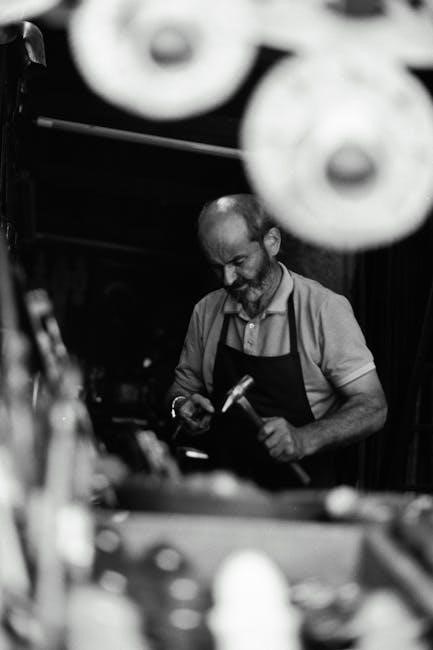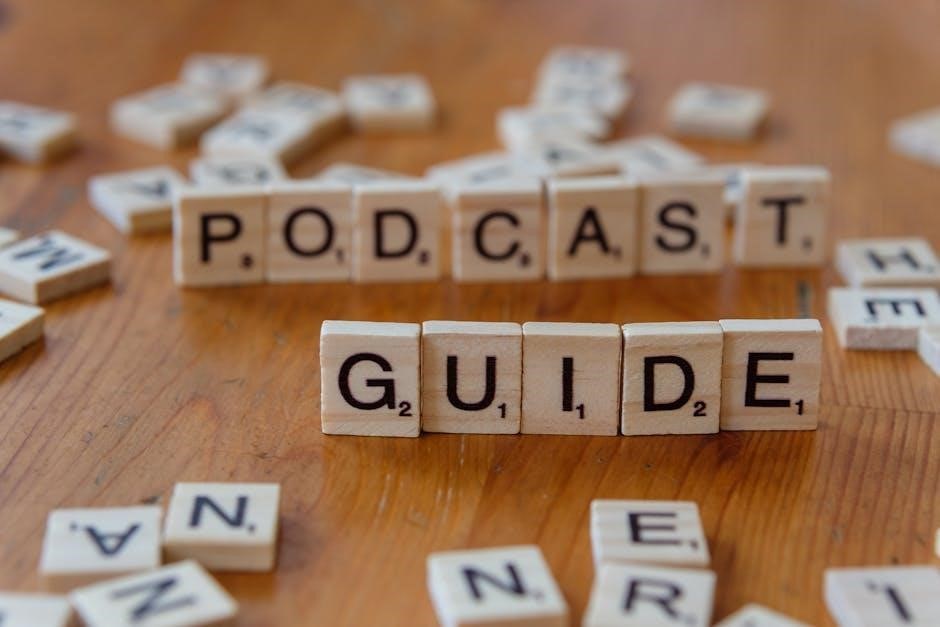Welcome to the Butterball Turkey Fryer Instruction Manual, your comprehensive guide to safely and effectively using this indoor electric turkey fryer. This manual covers everything from assembly to cooking, ensuring a perfect frying experience every time. Designed for both novice and experienced users, it provides detailed step-by-step instructions and essential safety guidelines. Follow these instructions carefully to achieve delicious results while maintaining safety in your kitchen.
Overview of the Butterball Electric Turkey Fryer
The Butterball Electric Turkey Fryer is a versatile and efficient kitchen appliance designed for indoor use. It features a stainless steel exterior and a removable inner pot for easy cleaning. With a maximum turkey capacity of 20 lbs, it allows for cooking whole turkeys or smaller portions. The fryer uses oil for cooking, with peanut oil recommended for optimal flavor and higher smoke point. Safety features include a short cord to prevent tripping and a heating element that only activates when properly secured. Perfect for holiday meals or special occasions, this fryer ensures crispy, delicious results every time.
Importance of Following the Instruction Manual
Adhering to the Butterball Turkey Fryer Instruction Manual is crucial for safe and successful operation. Proper assembly, cooking procedures, and maintenance ensure optimal performance and prevent potential hazards. Incorrect usage can lead to safety risks, such as oil spills or electrical issues. By following guidelines, users can achieve perfectly cooked turkeys while minimizing risks. The manual also provides troubleshooting tips and warranty information, making it an essential resource for maximizing the appliance’s efficiency and longevity.

Safety Precautions and Warnings
Always read and follow the instruction manual carefully to ensure safe operation. Never move the fryer when oil is hot, and keep children away. Avoid overfilling the fryer, and ensure it is placed on a heat-resistant surface. Proper ventilation is essential to prevent fumes buildup. Failure to follow safety guidelines may result in burns, fires, or electrical hazards. Prioritize safety to enjoy a secure and efficient frying experience.

General Safety Guidelines
Always handle hot oil with care to avoid burns. Keep the fryer away from children and pets. Never leave the fryer unattended during operation. Ensure the turkey is completely thawed before frying to prevent oil splatter. Do not overfill the fryer with oil, as this can lead to spills and accidents. Use the short cord provided to minimize tripping hazards. Place the fryer on a stable, heat-resistant surface. Following these guidelines ensures a safe and efficient frying experience.
Maximum Turkey Size and Weight Limits

Your Butterball Electric Turkey Fryer is designed to accommodate turkeys up to 20 pounds (9.07 kilograms). Exceeding this limit can lead to uneven cooking and safety hazards. Ensure your turkey fits within these specifications for optimal performance and safety. Using a turkey that is too large may result in incomplete cooking or damage to the fryer. Always check the turkey’s weight and size before frying to ensure a safe and successful cooking experience.

Assembly and Setup Instructions
Insert the hinge on the lid into the outer shell, attach the control panel, and secure the inner pot. Ensure all parts are correctly aligned and locked. Follow the provided parts list for clarity. Do not plug in the fryer until assembly is complete and all safety checks are performed. Proper assembly ensures safe and efficient operation of your Butterball Turkey Fryer.
Unpacking and Inventory of Parts
Begin by carefully unpacking all components from the box. The fryer includes an outer shell, inner pot, control panel, heating element, and mounting bracket. Check for a drain clip, instructional manual, and additional accessories like a seasoning kit. Ensure all parts are undamaged and accounted for. If any items are missing or damaged, contact Masterbuilt Customer Service at 1-800-489-1581. Proper inventory ensures smooth assembly and operation. Familiarize yourself with each part before proceeding.
Step-by-Step Assembly Process
Start by attaching the hinge to the lid and inserting it into the outer shell. Next, place the inner pot into the shell at an angle to align the valve correctly. Mount the control panel and heating element onto the bracket, ensuring it clicks securely. Attach the drain clip to the basket for easy oil drainage. Double-check all connections to confirm they are tight and properly aligned. Refer to the diagrams in the manual for visual guidance. Once assembled, your fryer is ready for preheating and use.
Preparing the Turkey for Frying
Ensure the turkey is completely thawed and pat dry with paper towels. Season the inside and outside, and optionally inject with marinade for enhanced flavor.
Thawing and Drying the Turkey
Thaw the turkey completely in the refrigerator or in a cold water bath, changing the water every 30 minutes. Pat the turkey dry inside and out with paper towels to remove excess moisture. This step is crucial for safe frying, as excess water can cause oil splatter. Ensure no ice remains, especially in the cavities, to prevent uneven cooking. Proper thawing and drying ensure the turkey fries evenly and safely.
Seasoning and Marinade Injection
Season the turkey inside and out with Butterball Turkey Seasoning for enhanced flavor. If desired, inject Butterball Marinade into the turkey, using 4 to 8 ounces on each side. Ensure the marinade is evenly distributed for consistent taste. This step adds moisture and flavor, making the turkey deliciously tender. Allow the seasoning to set for a few minutes before frying for optimal results. Always use the recommended products for the best outcome with your Butterball Turkey Fryer.

Operating the Butterball Turkey Fryer
Operating the Butterball Turkey Fryer involves setting the control dial to 375°F (191°C). Preheating takes up to 45 minutes. Once ready, carefully lower the turkey into the hot oil, ensuring a safe and even frying process.
Preheating the Fryer
Preheating the Butterball Turkey Fryer ensures optimal frying results. Set the control dial to 375°F (191°C). The preheating process typically takes 35-45 minutes. During this time, the heating element warms the oil to the desired temperature. It’s essential to wait for the oil to reach the correct temperature before adding the turkey. Always keep the lid closed during preheating to retain heat and ensure safety. Once preheated, the fryer is ready for cooking, providing a crispy and evenly cooked turkey. Proper preheating is crucial for achieving the best results. Use a thermometer if available to verify the oil temperature.
Cooking Time and Temperature Guidelines
The Butterball Turkey Fryer operates at 375°F (191°C) for optimal frying. Cooking time is typically 10 minutes per pound of turkey. For example, an 18-pound turkey takes about 180 minutes. Use a food thermometer to ensure the internal temperature reaches 165-170°F (74-77°C). Always check the thickest part of the breast and thigh. Larger turkeys may require additional time, so monitor closely. Proper temperature control ensures a crispy exterior and juicy interior. Adjust cooking time as needed for smaller or larger turkeys. Follow these guidelines for perfect results every time.
Cooking Times and Temperatures
Cooking times vary based on turkey size. Set the fryer to 375°F (191°C) for optimal results. Cook 10 minutes per pound or until internal temperature reaches 165-170°F (74-77°C).

Cooking Chart for Different Turkey Sizes
A 16-18 lb turkey is recommended, but you can fry up to 20 lbs. Cooking time is 10 minutes per pound at 375°F (191°C). Use a food thermometer to ensure the internal temperature reaches 165-170°F (74-77°C). For smaller turkeys, adjust the cooking time accordingly. Always follow the chart guidelines to achieve perfectly cooked, juicy meat. This chart ensures consistency and safety, making it easy to fry a delicious turkey every time.
Using a Food Thermometer for Accuracy
A food thermometer ensures your turkey is cooked to a safe internal temperature of 165°F (74°C) for the breast and 180°F (82°C) for the thigh. Insert the thermometer 2 inches into the thickest part of the breast and 1.5 inches into the thigh, avoiding bones. This guarantees even cooking and prevents undercooking or overcooking. Always use the thermometer throughout the frying process to maintain precision and ensure a juicy, flavorful result.
Cleaning and Maintenance
Regular cleaning ensures optimal performance and longevity. Disconnect power before cleaning, avoiding water on electrical components. Use paper towels to dry surfaces thoroughly after each use. Filter oil for reuse and clean the inner pot and heating element with mild soap. Proper maintenance keeps your fryer in excellent condition for future cooking sessions.

Post-Cooking Cleanup Procedures
After cooking, unplug the fryer and let the oil cool slightly before handling. Carefully pour the used oil through a filter or fine-mesh strainer into a sealable container for disposal or storage. Clean the inner pot, heating element, and basket with mild soap and warm water, avoiding abrasive cleaners. Rinse thoroughly and dry with paper towels to prevent rust. Wipe the exterior with a damp cloth and clean the drain valve with a small brush and mild soap. Regular maintenance ensures longevity and hygienic operation.
Storage and Long-Term Maintenance
For proper storage, ensure all components are clean and dry. Store the fryer in a cool, dry place, away from direct sunlight. Protect the heating element from moisture by covering it with a cloth or plastic bag. Regularly inspect the fryer for signs of wear or rust, and address any issues promptly. Avoid storing oil in the fryer for extended periods; transfer it to an airtight container. Follow these steps to maintain your Butterball Turkey Fryer in excellent condition for years of reliable use.

Troubleshooting Common Issues
Address common issues like uneven heating or oil temperature fluctuations by checking the heating element connection and ensuring proper oil levels. Consult the manual for detailed solutions to ensure optimal performance and safety.
Resolving Heating Element Problems
If the heating element isn’t functioning, first ensure it’s properly attached to the mounting bracket. Check for loose connections or debris blocking the element. Verify the power cord is securely plugged in and the outlet is working. If issues persist, reset the unit by unplugging it for 30 minutes. If the element remains unresponsive, contact customer support or replace it. Always refer to the manual for specific troubleshooting steps to avoid further damage or safety risks.
Addressing Oil and Temperature Concerns
Monitor oil temperature closely to ensure it reaches 375°F (191°C) for optimal frying. Use a food thermometer to verify accuracy. If temperature fluctuates, adjust the control dial gradually. Avoid overheating, as this can damage the unit or cause oil to smoke. For best results, use peanut oil or other high-smoke-point oils. Never exceed the maximum oil capacity. If oil levels drop below the minimum, add more as needed. Allow the fryer to preheat for 35-45 minutes before frying to maintain consistent heat throughout cooking.